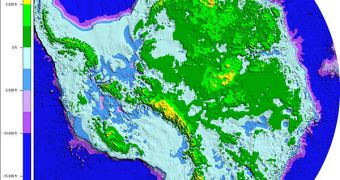Over the past few years, opponents to the idea that pollution and human activities are causing global warming and climate change have been using the situation in the Antarctic as their most solid argument. They said that the ice spreads in Eastern Antarctica were growing and that this was enough proof that people had nothing to do with rising sea levels and glacier meltdown. Now, a new scientific study will put an end to unfounded criticism, as the deep nature of the interactions currently taking place in Antarctica are revealed to the public.
At its time, the Fourth Assessment Report of the Intergovernmental Panel on Climate Change (IPCC) stated that Antarctica was the only continent where human activities had not been linked directly to decreases in ice levels. In a report published in the journal Nature Geoscience, UK researcher Nathan Gillett, from the University of East Anglia, says "We're able for the first time to directly attribute warming in both the Arctic and the Antarctic to human influences."
The report "demonstrates convincingly what previous studies have suggested: that humans have indeed contributed to warming in both the Arctic and Antarctic regions," added U.S. National Centre for Atmospheric Research scientist, Andrew Monaghan.
Gillett's team centralized all reports coming in from the 20 meteorological stations in the Antarctic, between 1990 and 2000, at the personal request of IPCC chairman Rajendra Pachauri. The researchers created several computer models, based on the information they gathered. The model that did not feature greenhouse gases (GHG) in it revealed a larger Antarctica, with ice spreading far more than it actually does today.
The computer model that took into account GHG portrayed an exact image of the Antarctic, up to this point in time. In the Antarctic Peninsula, temperatures have increased by as much as 3 degrees Celsius, which prompted the melting of several glaciers, as warmer ocean currents erode the ice at its base. In 2002, a huge portion of the ice shelf, the 3,250 square kilometer-wide Larsen B shelf – separated from the main land, sunk and melted in the Southern Ocean.
Statistics for 2006 look bleak. West Antarctica lost some 132 billion metric tons of ice, a significant increase from the 83 billion in 1996. The Antarctic Peninsula lost some 60 billion metric tons. Had it not been for the extra-cold Eastern Antarctica region, which simultaneously accumulated more ice, adding it to its 2,226-meter (7,300 feet) thick shelf, sea levels worldwide would have increased by half a millimeter.

 14 DAY TRIAL //
14 DAY TRIAL //